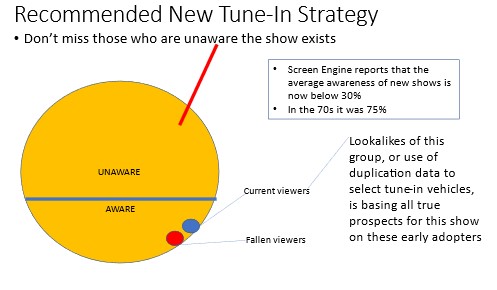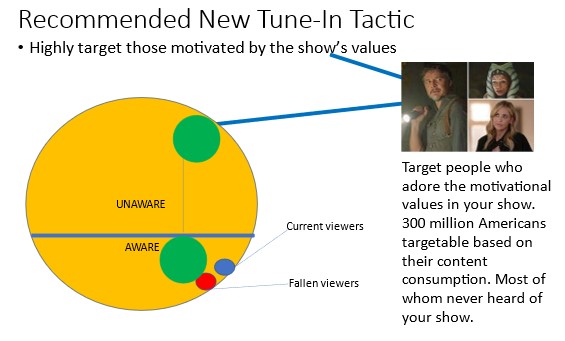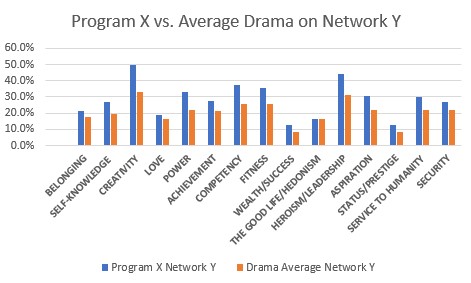 The networks used to be able to achieve 75% pre-launch awareness of the average new series using only a fifth of their own air time for tune-in promos. Today the average awareness of a new TV series is less than 30% according to Screen Engine. And this is despite the fact that the networks are now paying over a billion dollars a year to each other and to other media for paid tune-in, on top of the $16 billion of their own air time they use to promote viewing of their shows. Spending more and getting less is always a problem, and its practical solution will be provided in this report.
The networks used to be able to achieve 75% pre-launch awareness of the average new series using only a fifth of their own air time for tune-in promos. Today the average awareness of a new TV series is less than 30% according to Screen Engine. And this is despite the fact that the networks are now paying over a billion dollars a year to each other and to other media for paid tune-in, on top of the $16 billion of their own air time they use to promote viewing of their shows. Spending more and getting less is always a problem, and its practical solution will be provided in this report.
But first let us understand the scope of the problem. According to the National Association of Broadcasters (NAB) and Ampere Analytics, in 2022 the total investments globally in new TV/cinema content totaled $230 billion, nearly twice the level it was at ten years earlier. We can see this reflected in the number of new shows. In the mid-1970s in the U.S. there were an average of 22 new primetime scripted series introduced each year. By 2009 this number had climbed to 210. In 2022 the number was 591, almost triple 2009, and 27 times as many as in the mid-70s.
One favorable change is that today 70% of new series launches result in a show staying on the air for some number of seasons. This is not necessarily because the shows are better than they used to be in the mid-70s, when only 10% of new shows made it to a second season. It’s mostly because of the change in perspective.
Back then a new show was cancelled if it failed to get an 18 average minute rating. Nowadays a show gets to stay on the air even if it has only a 1 rating, which is considered pretty good now, whereas it was considered horrible back when.
But even a 30% failure rate has important monetary consequences. Variety reports that the average cost of these shows is $3 million to $7 million per hour, and when most new series launch they have 10 episodes in the can. That puts the average cost of a failure is about $50 million.
One question to ask is whether more, or more effective, tune-in can lower those losses. This is something which can be determined by in-market experimentation. But hold on a second. There is another concern.
The same fragmentation of television causing lower ratings also has another effect which we only discovered recently . The loyalty of a viewer appears to have dropped precipitously as a result of the overabundance of choice. As a result, episode to episode, a series sees its ratings going up and down much more than in the Golden Age.
This is highly relevant to tune-in, which can be used to tantalize viewers with a few scenes from the next episode, and if used effectively and continuously this could stabilize the audience.
Up to now, tune-in has been used mostly for new season premieres, and there are many shows that are given almost no tune-in on a continuous basis. That would have to change if one wanted to see steadier ratings for all series on a network.
We have now scoped the problem and its causes and hinted that the solution lies in the direction of more and more effective tune-in. How would we achieve that, is it just throwing more money at it? Are there any systemic problems with current tune-in that can be identified and improved upon? Yes.
In the search for best practices in the industry, with people changing jobs from one studio or network to another, everyone winds up doing things the same way. For example, in tune-in, today the common practice is to advertise Program A on Program B if there is a lot of audience duplication between the two shows. This is perfectly reasonable. Nielsen and now others as well are providing audience duplication data, Nielsen has been doing it since the 60s, and gradually all the networks found the duplication hammer for the tune-in nail.
What’s wrong with that method? Two things.
One, before the new show premieres it does not have an audience let alone an audience duplication pattern. So people guess at probable duplication based on similarities they see between shows.
The second problem is the real killer. It’s the low awareness problem. The duplication between Program A and Program B is between people who were aware of both series. By definition, that approach is leaving out the other 70% of people who might love your new series, but don’t know that it exists. How do you find people who will love your new series?
You can find people who love certain values that are highly present in your new series. That’s the link. The way you can find people unaware of your new series but very likely to find it their cup of tea.
A company I co-founded, RMT, has trained the Semasio AI to reproduce the 15 RMT Motivations and measure their presence within 300 million Americans who browse the open Web. If you have a new show that has characters who are heroic and creative, we can find a targetable advanced audience of tens of millions of people who would love a show like that, because the content they consume on the internet has high doses of Creativity and Heroism/Leadership.
Modest programmatic digital tests matched with available set top box data from any supplier can determine how well the method increases ratings, and when you see that it works, you can do the math to weigh scaling up use of the method.
Tactically, you might test a mix of premium digital video, nonpremium digital video, and display. Example of a display ad: picture of the main character with the words Creative Hero and the name of the series. The user interested by this would click to see the trailer. All three tactics would be tested against the same advanced audience targets known to consume content related to Creativity and to Heroism/Leadership.
By increasing the effectiveness of tune-in, more new series launches can remain on the air longer, with more lucrative audience sizes. With the vast investments being made and the overturning of the “natural order” in television, every reasonable idea deserves to be tested with care.



